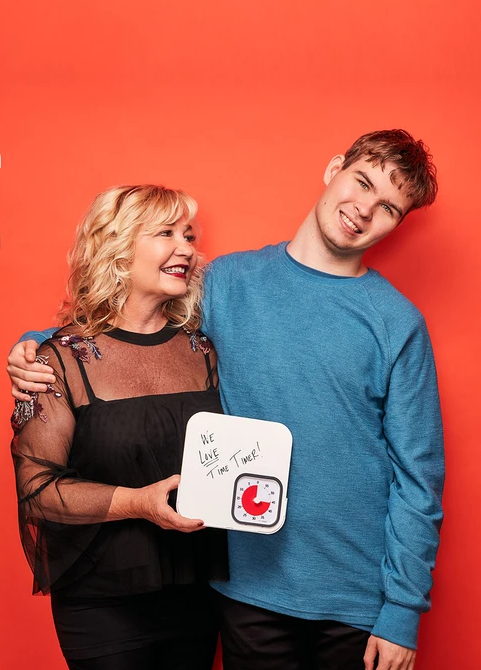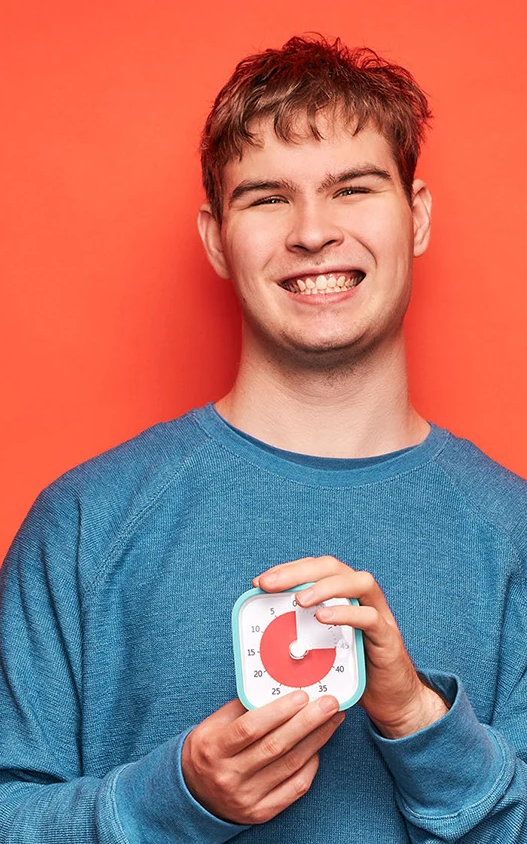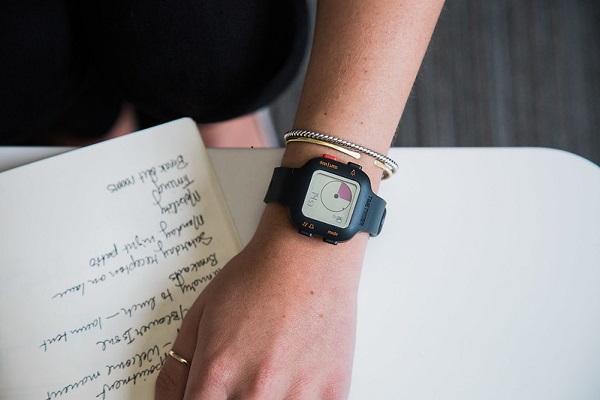How Community Support and Self-Education Leads to Self-Advocacy and Shoulder Hugs:
The Story of Terri and Bayley
Terri has been long-time Time Timer fan. She was first introduced the Time Timer visual timer back when her son, Bayley, was a small child. After finding out that he was diagnosed with Autism, she whole heartedly engulfed herself in learning everything she possibly could to ensure that she gave her child the best life possible, everything from strategies to tools. This is when she was first introduced to Jan Rogers, inventor and founder of the Time Timer visual timer. As she tells us in this interview, the drive to educate herself and the support of her community helped her provide Bayley with a life that fostered his self-confidence. Hear in Terri’s, and a few of Bayley’s own words, what it was like to watch Bayley grow and blossom into adulthood.
What has been the best piece of advice you have received as a parent of a child with Autism that you would like to share with others?
It is important to be patient. I re-call when I began my journey in learning about visuals, schedules, PECs, sequencing and so on, it seemed almost impossible to me that I could make this a success for Bayley. I got very frustrated. One day at a presentation to learn more about visual learning for Autism a very nice woman was sitting next to me. She knew I was frustrated. She actually took my hand and said, “It will all fall into place and your son will be fine.” Many years later I realized she was right. We need to understand this path will take patience and we need to embrace the little things along the way. It is overwhelming in the beginning because there are so many options and ideas and therapies that we can consider. We need to take our time, study what is out there and try to think like our child. Try to become them and get into their world…. We need to know it will all be okay.
Bayley was so young when he was diagnosed with Autism. How did it effect you as a parent? How did it effect Bayley?
Bayley got diagnosed at 2 ½. I do not think it effected Bayley, but it changed my life immensely. In many good ways and I became involved in a world that I have grown to love.
Being new to the special needs world I realized I needed to go back to school and learn everything I could about Autism. I was determined to give my son every single chance in life so one day he may become an independent member of our community. I signed up for every class possible. I became so interested in learning more. Then I loved sharing what I learned with others so I could help make their lives easier. I also got involved in many organizations, circled myself with many parents in my new world, volunteered and kept learning. I believe getting involved is the key to success for me. Give back – the more you get involved, the more you help others, the less you feel alone and you become happy and okay. I learned if I am happy, Bayley is happy.
What are some ways that you and Bayley have maintained a schedule throughout the day?
We began with using a visual picture schedule. I think I laminated pictures 24/7 at one point. I created “first and then” cards, “command cards” – for example: “feet down”, “no hitting” and so on. Began the learning process first in pictures. Then we graduated to words with pictures for his schedule. Then as he began to emerge, we grew to writing in a planner and we would write in short sentences. It truly is amazing to watch the progression over the years. Bayley is a very visual learner to this day, and he is now 22. We still make a daily schedule. This helps him organize his day. Just like I use a planner, I write myself notes and use our calendar on our phones…. we all need to or we find it difficult to focus; imagine having Autism.
What is the best part of being Bayley’s mom?
I have loved Bayley from the moment he was placed in my arms. Bayley is adopted. We were there at his birth. He was a preemie and only weighed 3 1/2 pounds. We spent the first month with Bayley in the ICU; but he finally hit 4 pounds and we were able to take him home.
He did get diagnosed with autism at 2 1/2 and that is when our journey began. I will never forget his first words to me. He was about three years old. He was not verbally communicating prior to this. After attending many seminars on communication, I learned we had to put all of his toys and trains and things he liked to play with up on shelves – the reasoning for this was to cause him to try to communicate to us what he wanted. The very next morning after putting up shelves all over our home, Bayley came to me and tugged at my arm and said, “mama, green train.”
I jumped up immediately and ran to get his trains… it was at that moment I knew he had a voice, and I was able to get him into speech therapy and ABA therapy to help develop his communication.
I love how he will be in the car and he will ask me for a shoulder hug. He will lay his head on my shoulder. It is priceless. He is extremely loving and fun and he loves to throw kisses.
How do you suggest others support friends or family they know who have received an Autism diagnosis?
I ask that friends and family try to be there for us. Try to get involved and learn about autism. Keep including us and not to abandon us. Have patience and understand that our life is different. Embrace our world and support inclusion.
How old is Bayley now and what has he been up to?
Bayley is 22 now. He recently “aged” out of school. He is now in the adult world. It was difficult for him at first. The lack of routine and transition was challenging. With the help of many, he is involved with a great program at the University of Cincinnati and continues ABA therapy. He will start to volunteer shortly in the school he went to.
Having raised a child to adulthood, what would you say about the journey so far? Has it been easier or harder at different stages of life?
I think at every phase there can be challenges and there are also many reasons to celebrate. My advice would be to never stop learning and keep the routine and system going that works for your child. I notice if I start my day and think it is ok not to make a schedule that day, it ends up not ok. For our son, visual schedules help him know what to expect and this is calming to him. We need to continue to advocate for our child and throughout adulthood. Every stage of maturing, just like we all faced, needs preparation, education, love and patience.
How did Bayley’s autism make him who he is today? What do you see as his strengths and talents?
I think we all need a little “Bayley” in us. He is innocent and it is refreshing to me. He likes to sing, enjoys a very simple life, likes music and loves to go the Cincinnati Reds games. He is very good at organizing. He loves to mow the lawn and is really good at it. He has recently expressed an interest in learning how to play golf. I feel he will continue to emerge. He tells me this, “mama, when I was little, I said no, I cannot. Now I say I can, and I will”! I believe this to be true.
What is your favorite Time Timer product and how did you use it with Bayley? Does he still use a Time Timer today? How has it been used differently throughout your family life?
I have loved Time Timer products for years. We like the watch, the small timer [Time Timer Origina Pocket], the timer you can carry that has a handle [Time Timer PLUS] and the large timer [Time Timer Original Large] to place above a desk. Bayley is a visual learner, so the Time Timer products help him organize his day and help his stay focused. I am interested in the new Time Timer [WASH] product that tracks the time when you wash your hands, very cool idea.
A little more about Terri!
Terri attended the University of Cincinnati and graduated with a degree in Early Childhood Education. Terri spent her early career in Human Resources and then spent time working in the travel industry. She recently retired from her positions as CEO at Contemporary Cabinetry East and is working towards opening her own business where a percentage of the employees will have Autism Spectrum Disorder. After Bayley’s diagnosis, Terri became involved in the Autism community and has been involved in a number of organizations including, the Autism Society of Greater Cincinnati, Regional Autism Advisory Council, Visionaries and Voices, Stepping Stones, and many more. Terri has also received several awards for her involvement in the Autism community. Terri has dedicated her time to educate herself about Autism and share what she has learned to help others.





